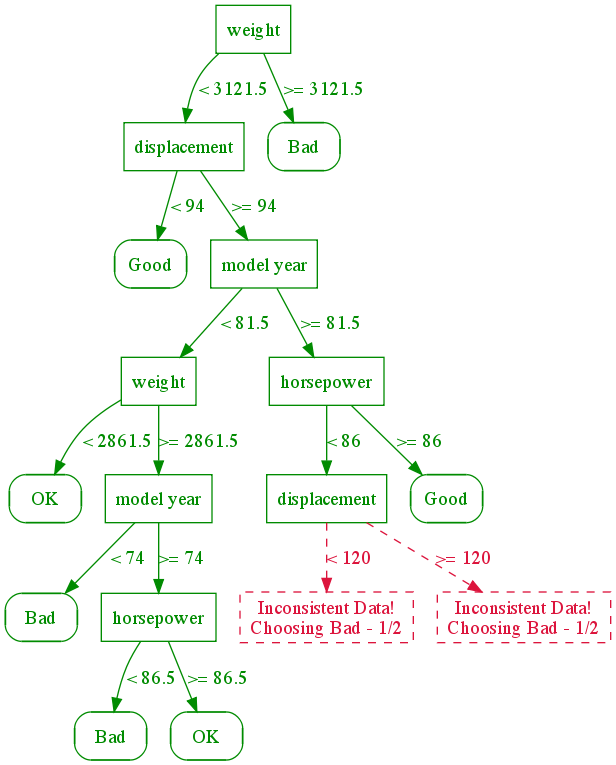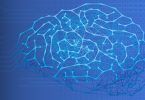Here we explain how to use the Decision Tree Classifier with Apache Spark ML (machine learning). We use data from The University of Pennsylvania here and here. We write the solution in Scala code and walk the reader through each line of the code.
Do not bother to read the mathematics part of the lecture notes from Penn, unless you know a lot of math. Such knowledge is not necessary here. Instead this graphic below gives you all that you need to understand the basic idea:
The goal is to look at automobiles and predict gas mileage. The mileage is either bad (0), good (1), or ok (2) based on number of cylinders, engine displacement, horsepower, weight, acceleration time to 60 mph, model year, and continent of origin. Below the graph is the data in spreadsheet format with text, and below that, the text is converted to numbers.
(This tutorial is part of our Apache Spark Guide. Use the right-hand menu to navigate.)
The graph below describes how the decision tree works. First you look at the weight. If it is heavy the mileage is bad. If it is not heavy and the engine displacement is high then you have to look at model year. You keep dividing this problem until you get to a point where logically it makes no sense to go any further. Obviously if a car weighs a whole lot, then rightaway you can say that its mileage will be bad.

Graphic Source: University of Pennsylvania
Here is the data with column headings.
| mpg | cylinders | displacement | horsepower | weight | acceleration | modelyear | maker |
|---|---|---|---|---|---|---|---|
| Bad | 8 | 350 | 150 | 4699 | 14.5 | 74 | America |
| Bad | 8 | 400 | 170 | 4746 | 12 | 71 | America |
| Bad | 8 | 400 | 175 | 4385 | 12 | 72 | America |
| Bad | 6 | 250 | 72 | 3158 | 19.5 | 75 | America |
| OK | 4 | 121 | 98 | 2945 | 14.5 | 75 | Asia |
| OK | 6 | 232 | 90 | 3085 | 17.6 | 76 | America |
| OK | 4 | 120 | 97 | 2506 | 14.5 | 72 | Europe |
And here it is converted to numeric format so we can use it with the ML algorithm. Download that data from here and save it to your drive or put it in Hadoop.
0 8 350 150 4699 14.5 74 0
0 8 400 170 4746 12 71 0
0 8 400 175 4385 12 72 0
0 6 250 72 3158 19.5 75 0
0 8 304 150 3892 12.5 72 0
0 8 350 145 4440 14 75 0
0 6 250 105 3897 18.5 75 0
0 6 163 133 3410 15.8 78 1
0 8 260 110 4060 19 77 0
1 4 97 75 2171 16 75 2
1 4 97 78 1940 14.5 77 1
1 4 98 83 2219 16.5 74 1
2 4 79 70 2074 19.5 71 1
2 4 91 68 1970 17.6 82 2
2 4 89 71 1925 14 79 1
2 4 83 61 2003 19 74 2
Scala Code
Run spark-shell or create a Zeppelin notebook and paste in the code below.
import org.apache.spark.mllib.tree.DecisionTree
import org.apache.spark.mllib.tree.model.DecisionTreeModel
import org.apache.spark.mllib.util.MLUtils
import org.apache.spark.mllib.linalg.Vectors
import org.apache.spark.mllib.regression.LabeledPoint
import org.apache.spark.mllib.feature.Normalizer
// read the data file and split it by spaces
val data = sc.textFile("/home/walker/mileage.txt").map( l => l.split("\\s+"))
// convert every string to doubles
var dbl = data.map (m => m.map(l => l.toDouble))
// Here we create a Dense Vector and LabeledPoint. A Dense Vector is a
// special kind of Vector than the scala regular Vector. So use Vectors, with an “s”
// at the end. The values must be doubles. A Dense Vector cannot handle
// blank values. If we had that those, we would use a Sparse Vector.
//
// The LabeledPoint is an object with the label and features. The label
// is 0, 1, 2 or gas mileage and the features are the weight, year, etc.
val parsedData = dbl.map { y =>
val c = Vectors.dense(y(1),y(2),y(3),y(4),y(5),y(6),y(7))
LabeledPoint(y(0), c)
}.cache()
// numClasses means number of classifications. In this case it is
// 0, 1, or 2
val numClasses = 3
// Here we say that the 6th feature is categorical with 3 possible values.
// It can be American, European, or Asian.
// The rest of the values are continuous, meaning just numbers and not discrete
// values.
val categoricalFeaturesInfo = Map(6 -> 3)
val impurity = "gini"
val maxDepth = 9
val maxBins = 7
// Now feed the data into the model.
val model = DecisionTree.trainClassifier(parsedData, numClasses, categoricalFeaturesInfo , impurity, maxDepth, maxBins)
// Print out the results
println("Learned classification tree model:\n" + model.toDebugString)
Results:
DecisionTreeModel classifier of depth 5 with 21 nodes
Here it says that we have 21 nodes (bottom endpoints) and 5 levels of decisions to make. For example if feature 3 (weight) [We start numbering at 0.] is <= 2930 then we have to look at feature 1 (displacement and so on) to derive our prediction of 0, 1, 2.
If (feature 3 <= 2930.0) If (feature 1 <= 91.0) Predict: 2.0 Else (feature 1 > 91.0) If (feature 5 <= 81.0) If (feature 2 <= 105.0) Predict: 1.0 Else (feature 2 > 105.0) If (feature 0 <= 4.0) Predict: 0.0 Else (feature 0 > 4.0) Predict: 1.0 Else (feature 5 > 81.0) If (feature 2 <= 85.0) Predict: 0.0 Else (feature 2 > 85.0) Predict: 2.0 Else (feature 3 > 2930.0) If (feature 3 <= 3193.0) If (feature 2 <= 85.0) Predict: 0.0 Else (feature 2 > 85.0) If (feature 2 <= 105.0) If (feature 0 <= 4.0) Predict: 1.0 Else (feature 0 > 4.0) Predict: 0.0 Else (feature 2 > 105.0) Predict: 0.0 Else (feature 3 > 3193.0) Predict: 0.0
We would then save this model and use the predict() method to pass in one particular vehicle to predict what kind of mileage it will have.
You might have noticed that this kind of model is similar to logistic regression. But we use decision trees (there are several types) when we want to handle much data as it is less computationally expensive. In other words it runs faster and consumes less memory.
Also note that the Penn lecture used the matlab math and stats programming tool. But those kinds of tools cannot work with big data. They do not scale like Apache Spark to millions of decisions or more.







